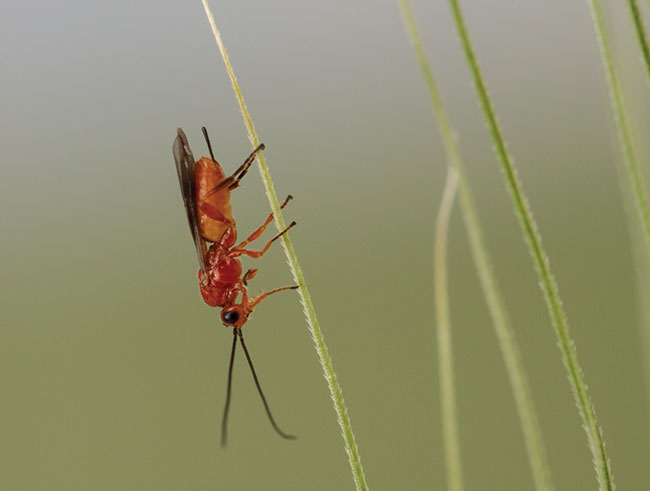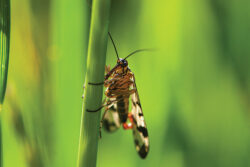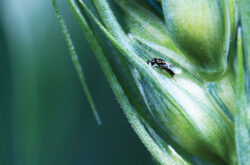
Features
Insect Pests
Making the most of a bug-eat-bug world
Quantifying the economic value of beneficial insects that help control pests in Prairie crop fields.
June 21, 2023 By Carolyn King
 The parasitoid Bracon cephi attacks the wheat stem sawfly, a major wheat pest on the Prairies; it may be an important regulator of the pest’s population cycles.
Photo courtesy of S. J. Barkley.
The parasitoid Bracon cephi attacks the wheat stem sawfly, a major wheat pest on the Prairies; it may be an important regulator of the pest’s population cycles.
Photo courtesy of S. J. Barkley. Entomologist Haley Catton knows that a diverse “unpaid army” of beneficial insects are quietly defending Prairie crops against pests. But exactly which species of these biocontrol beneficials are in a field at any given time? Are these beneficials vulnerable to the “friendly fire” of insecticides that can kill beneficials along with the target pests? And what is the economic value of the crop defence services provided by these beneficials?
Catton and her colleagues are seeking to answer such questions. Their ambitious long-term goal is to provide practical information on biocontrol beneficials so Prairie crop growers can factor these beneficials into their pest management decisions.
“As crop entomologists, we work on the insects in agricultural fields. Most people think of pests when they think of such insects. But there is a whole ecosystem of insects in crop fields, and lots of them are providing valuable services like pest control, pollination and nutrient cycling,” explains Catton, a research scientist with Agriculture and Agri-Food Canada (AAFC) in Lethbridge.
“There are two main categories of biological control beneficials: predators, which are hunters such as lady beetles that eat pest insects; and parasitoids, which are teeny, tiny insects that lay their eggs inside crop pests. Those eggs hatch into juveniles that eat the pests from the inside out.”
As in making any other decision, crop growers need to be able weigh all the pros and cons when making pest control decisions. “When you are deciding whether to spray for a pest that is near or above the economic threshold, you know the pros such as reducing the pest’s population and minimizing your yield loss. But the cons of knocking out the beneficial insects are unseen,” she says.
“When a field is sprayed with a foliar pesticide, that pesticide will knock out the pest, which is great. But it could also take out beneficials and the services they are providing behind the scenes. Let’s say you sprayed for aphids, but the insecticide also killed the cutworm parasitoids in your field. The next time cutworms start resurging, you wouldn’t have those parasitoids to control the cutworms.”
Catton emphasizes, “We want to be able to give farmers all the tools they need for making fully informed decisions about what is best for managing the current and future pest problems in their fields.” She is currently leading a project that represents an important initial stage in reaching this challenging goal. The project is funded by Results Driven Agriculture Research, Sask Wheat, Alberta Barley and the Alberta Wheat Commission.
Sifting through a mountain of data
The project’s objectives are: 1) to summarize what is already known about the many species of insects, spiders and other arthropods that control insect pests and/or eat weed seeds in Prairie cereal and canola crops; and 2) to create a roadmap for future research to develop the information on biocontrol beneficials that crop growers need.

A parasitoid wasp, which is beneficial to plants and crops.
Photo Credit: Tatiana/ Adobe Stock.
This work may sound fairly straightforward. In fact, it is a daunting task that requires the efforts of many players. The project team includes seven federal entomologists, one university entomologist, and three provincial entomologists, as well as a bio-economist, a weed scientist and an insect population modeller.
The team members are currently sifting through all the available data on biocontrol beneficials in Prairie crops.
Of course, part of the team’s work is to summarize the findings from economic studies about Prairie biocontrol beneficials. However, there have actually been very few such studies.
The team members also have a much bigger and more fundamental task. They are pulling together all the existing information about the many different species of biocontrol beneficials present in Prairie crop fields and each species’ phenology – the seasonal timing of its life cycle stages.
“We need the phenology information to help farmers make decisions on spraying. Let’s say a farmer needs to spray for aphids. We want to be able to, for example, give them a diagram of what beneficials are out there at spraying time that could be harmed by the pesticide,” Catton notes.
“Some of our information is coming from the published literature, and some is through re-purposing data that we have collected for other projects. For example, we have unpublished data on beneficials that we have picked up on the side during our studies of pest insects. So, we are scouring our filing cabinets for this untapped information.”
This is a massive job. “On the Prairies there are 80 species of ground beetles roaming through crop fields, and most of them are hunters preying on pest insects on the ground. That’s a lot of diversity, and that’s just one group of insects. That’s not counting the lady beetles, the lacewings, and other predators, or the many parasitoid species,” she explains.
“Right now, I’m working on a dataset of 100,000 ground beetles that I collected for a previous project. Not only do we have some very large datasets, but it’s also quite difficult to pull out reliable seasonal timing information from the data because it depends on the exact sampling methods used in each individual case.”
Once the team members have compiled and assessed everything already known about Prairie biocontrol beneficials, they’ll be able to see where the knowledge is relatively strong and where the gaps are.
With that foundation, they can build a research roadmap.
Catton says, “The idea is that researchers and funders could use that roadmap to determine where they see the highest priorities for further research.”
Down the road
Providing practical economic and ecological information on biocontrol beneficials to crop growers could help growers to control pests with less insecticide, which could have multiple benefits.

Macroglenes penetrans is a parasitoid that attacks the wheat midge. One study estimated this parasitoid was responsible for savings of over $248 million in reduced insecticide use in Saskatchewan in the 1990s.
“Reducing unnecessary insecticide use would lower input costs. It would maintain beneficial insects that help prevent future pest problems,” Catton says. “It would also lower the risk of pollution from insecticides, slow the development of insecticide resistance, reduce carbon emissions from fuel consumption in the production, transportation and application of insecticides, and conserve biodiversity.”
The information from biocontrol beneficials research could someday also help in developing policies and programs to encourage practices that reduce unnecessary pesticide use. She gives one example: “Right now, in a situation where a farmer is not sure whether or not they have reached the economic threshold to spray, the farmer assumes the risk if the crop gets wiped out by the pest. They have a valuable investment to protect. So, in the short-term, it is often economically safer to spray in a borderline situation. If we collect enough data on beneficials over the years, there could be a persuasive case to consider developing some kind of data-based program that would incentivize farmers economically to not use insecticides in such situations.”
The work of Catton and her colleagues to determine the value and vulnerability of Prairie biocontrol beneficials is a key piece in enabling farmers to make optimal use of their free but fierce little crop guardians.
More information about beneficial insects that help control pests in western Canadian crops is available at fieldheroes.ca.